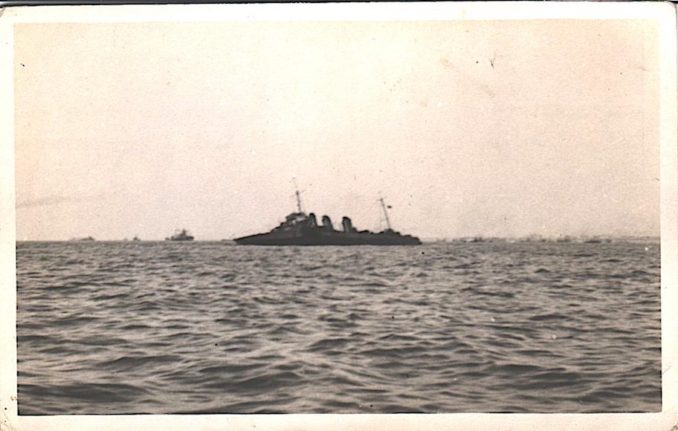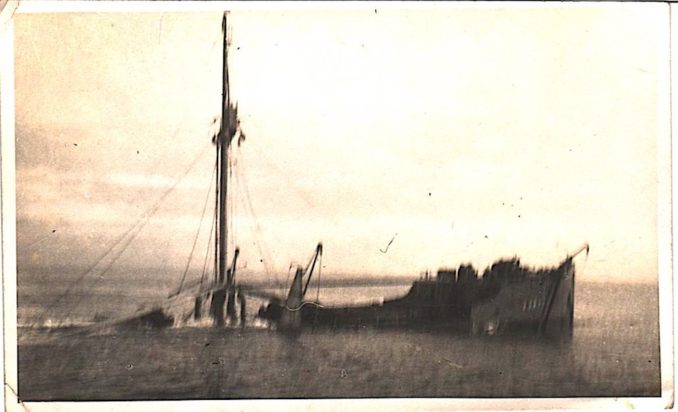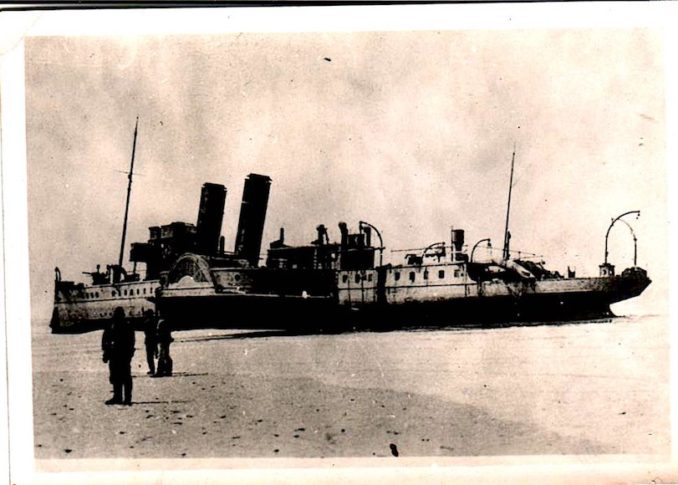In memory of those who have crossed the bar
Fearless of storm or foe,
Guarding the traffic of the east and west,
Giving with hearts heroic of their best,
The brave mine-sweepers go.
Horace Rumsam (1902-1949)
Horace was born in Swansea 23/6/1902 but lived in Ilfracombe as a lad. Perhaps seeking better prospects than those available at the time in North Devon, he became a merchant seaman aboard the SS Reading and travelled to the United States and Australia during his pre-1939 career, but came back to Blighty & married a Gloucestershire widow woman, Gwen, in 1932. Gwen had a boy, VBM – born 1925, by her deceased first husband OVM, (of VBM, more later) – but he was packed off to board at the Masonic School for Boys in Bushey in 1934. We in 2022 may look askance at that, but in the world of a working class family before the arrival of the safety net of the welfare state, a paid for gift horse of bed/board/education for a child was not to be sniffed at. So far so fairly typical of the life for many in the UK during the first third of the twentieth century.
At the outbreak of war in 1939, Horace joined the Royal Naval Reserve and served uneventfully on several of the Channel paddle steamers that had been converted & adapted for minesweeping duties around the southern coastline of England. Meanwhile, the Battle of France had begun in earnest on 10 May 1940. To the east, the German Army Group B invaded the Netherlands and advanced westward. In response, the Supreme Allied Commander, French General Gamelin initiated “Plan D” and British and French troops entered Belgium to engage the Germans in the Netherlands. Post 1918, French planning for defence relied on the Maginot Line of fortifications along the German–French border protecting the region of Lorraine but crucially the line did not cover the Belgian border. German forces had already crossed most of the Netherlands before the French forces had arrived. Gamelin instead committed the forces under his command, three mechanised forces, the French First and Seventh Armies and the British expeditionary Force (BEF), to the River Dyle, & the stage was set for the Battle of Hannut, commencing May 12th 1940.
This was the first big tank battle of WW2 with 411 French tanks (3e DLM and 2e DLM) facing 674 German tanks (4.PzD and 3.PzD). On 12th May only the 4.PzD was really involved, the 3.PzD having completely crossed the Meuse River on the 13th May. The 3e DLM (General Langlois) had to to face directly 2 Panzerdivisionen : 3.PzD (General Stumpff) and 4.PzD (General Stever). The 2e DLM General Bougrain (of him, more later) was held in reserve. Therefore the 674 German tanks including 132 Panzer III and Panzer IV were opposed by 239 French tanks including 88 Somua S35 tanks. Unlike the French troops, the Germans had a strong air support. The VIII.Fliegerkorps (General von Richtofen) with 300 Ju87 “Stuka” dive bombers and 42 Hs123 “assault” biplanes and about 130 Me109 supports were engaged over the Meuse River. To the IV.Fliegerkorps and IX.Fliegerkorps add some 280 He111/Do17/Ju88 bombers and over 500 Me109 and Me110. On the French side each DLM had only 3 modern reconnaissance aircraft attached.
As expected in tank versus tank warfare, the inefficiency of the 37mm SA18 L/21 gun of 80% of the Hotchkiss tanks was quickly demonstrated. It was unable to destroy the Panzer III and Panzer IV at 100m but on their side the Germans soon realized the inefficiency of their Panzer I and Panzer II light tanks against the French tanks and the inefficiency of their 3.7cm L/45 tank gun against the French armour at standard range (300-400m). Apart from the 7.5cm L/24 gun of the Panzer IV, no German shell could pierce the Somua S35 and the Hotchkiss H39 at a really comfortable range, they had to move to close range. According to the war diary of the 3.Panzerbrigade (3.PzD) commanded by Colonel Kühne :
“Huge quantities of ammunition were used during the battles against French tanks because of the lack of power of the 2.0cm and 3.7cm guns. In our brigade, all the 3.7cm and 7.5cm shells were used during a single battle on 13th May. Our unit had to wait for ammunition supply to continue to fight.”
German sources agreed that the “only really effective” German tank weapon against French armor was the 7.5cm KwK firing APCBC shells. The same source from 3.Panzerbrigade concludes that their 3.7cm gun was effective only at less than 200m range.
During the battle, the advancing German tanks were very often attacked on the flanks and the rear by the French tanks. Each counter-attack launched by a small formation of Somua S35 tanks is seen as critical but the French tanks fired also many times from static positions, using hull down emplacements at medium/long range to engage more numerous German tanks and meticulously fired at them from a safe position. The good armour and the powerful 47mm L/32 SA35 of the Somua S35 tank coupled to a 4x gunsight made it able to engage safely every German tank at 800m. At this range it was almost impossible for a German tank to destroy the Somua S35. The reports from the Panzerbrigade 3 indicate even that the 3.7cm gun was inefficient beyond 200m. Many Somua S35 tanks came back with 20-40 marked hits without any damage. The Somua S35 tanks had to be neutralized by the Panzer III, Panzer IV and AT guns at close range and by the 8.8cm FlaK or 10.5cm leFH in direct fire at longer range.
For 2 days the 3e DLM – and the 2e DLM – managed to stop 2 Panzerdivisionen and to inflict on them heavy losses. In reality the losses were heavy on both sides and the result of the battle became a stalemate. The French lost 105 tanks (75 Hotchkiss H35/H39 and 30 Somua S35 tanks) mainly in the 3e DLM and the Germans about 164 tanks but the German mobile field workshops were set up to work during the night to repair many of the tanks that were knocked out during the battle.
On 12th-13th May, the French cavalry corps blocked the German advance about 30 km in front of Gembloux. General Prioux had been ordered to delay the Germans until 14th May and moved 10 km back in the area of Perwez held by the 4e GRDI (Colonel Arlabosse), the reconnaissance group of the 15e DIM. The 4e GRDI included motorcycle platoons but also 13 Laffly 50 AM and 12 Citroën-Kégresse P16 Mle1929 armoured cars. There were no natural elements really useful to build a defence, only several dispersed and rather useless “Cointet” mobile AT obstacles. During this time the Luftwaffe attacked the rear of the French line, as on the frontline the French and German troops were too closely mixed. Fuel supply issues forced the XVI.Panzerkorps to stop at Jauche-Ramilles. At 21h00, the 3e DLM was deployed in its new positions and the 2e DLM was deployed early on 14th May.
On that day, German Army Group A burst through the Ardennes and advanced rapidly westward toward Sedan, before turning northward to the Channel. Effectively the Allied forces had been flanked. A series of Allied counter-attacks, failed to sever the German spearhead, which reached the coast on 20 May, & by 26th May, the BEF & French 1st Army were bottled up in a corridor to the sea, about 60 miles deep & 15 miles wide. Most of the British forces were still around Lille, over 40 miles from Dunkirk with the French further south. On 24 May, Hitler had visited General Von Rundstedt’s headquarters at Charleville. The terrain around Dunkirk was thought unsuitable for armour & Von Rundstedt advised him the infantry should attack the British forces at Arras, where the British had proved capable of significant action, while Kleist’s armour held the line west and south of Dunkirk to pounce on the Allied forces retreating before Army Group B. Hitler, who was familiar with Flanders’ marshes from the First World War, agreed. This order allowed the Germans to consolidate their gains and prepare for a southward advance against the remaining French forces.
The true reason for the decision to halt the German armour on 24 May is still debated. One theory is that Von Rundstedt and Hitler agreed to conserve the armour for Fall Rot (“Case Red”), an operation to the south. It is possible that the Luftwaffe’s closer ties than the army’s to the Nazi Party contributed to Hitler’s approval of Göring’s request to destroy the forces penned up in Dunkirk. Another theory — which few historians have given credence — is that Hitler was still trying to establish diplomatic peace with Britain before Operation Barbarossa (the invasion of the Soviet Union). Although von Rundstedt after the war stated his suspicions that Hitler wanted “to help the British”, based on alleged praise of the British Empire during a visit to his headquarters, little evidence that Hitler wanted to let the Allies escape exists apart from a self-exculpatory statement by Hitler in his political statement of 26th February 1945 which lamented that Churchill was “quite unable to appreciate the sporting spirit” in which he had refrained from annihilating the British Expeditionary Force at Dunkirk. However, this hardly squares with the contemporary record. Directive No. 13, issued by the Supreme Headquarters on 24 May called specifically for the annihilation of the French, English and Belgian forces in the pocket, while the Luftwaffe was ordered to prevent the escape of the English forces across the Channel.
Whatever the reasons for Hitler’s decision, the Germans confidently believed the Allied troops were doomed. American journalist William Shirer reported on 25 May,
“German military circles here tonight put it flatly. They said the fate of the great Allied army bottled up in Flanders is sealed.”
BEF C-inC General Lord Gort agreed, writing to Anthony Eden,
“I must not conceal from you that a great part of the BEF and its equipment will inevitably be lost in the best of circumstances”.
Hitler did not rescind the Halt Order until the evening of 26 May. The three days thus gained gave a vital breathing space to the Royal Navy to arrange & coordinate the evacuation from Dunkirk of the British and Allied troops back to the UK. The paddle steamers brought in to assist were invaluable as, with their relatively flat hull, they could approach the piers & shore much closer than conventional vessels. This of course did make them vulnerable to stranding when fully (over) loaded on a falling tide & hence a sitting duck for attack from the air. For Horace Rumsam, a bridge officer on the 792-ton paddle minesweeper, HMS Queen of Thanet, a rite of passage into the unholy maelstrom that was the beaches & piers of Dunkirk was only just beginning………….

© DJM 2022, Going Postal

© DJM 2022, Going Postal

© DJM 2022, Going Postal

© DJM 2022, Going Postal
The attached photographs were taken by Horace – mostly from the bridge – and are part of my family history. Some of them have his writing (in pencil) on the reverse, which enables certain items to be identified. These articles are a testament to his – & so many others – intestinal fortitude – & hopefully a fitting tribute & memorial to a world & people long gone.
© text & images DJM 2022



